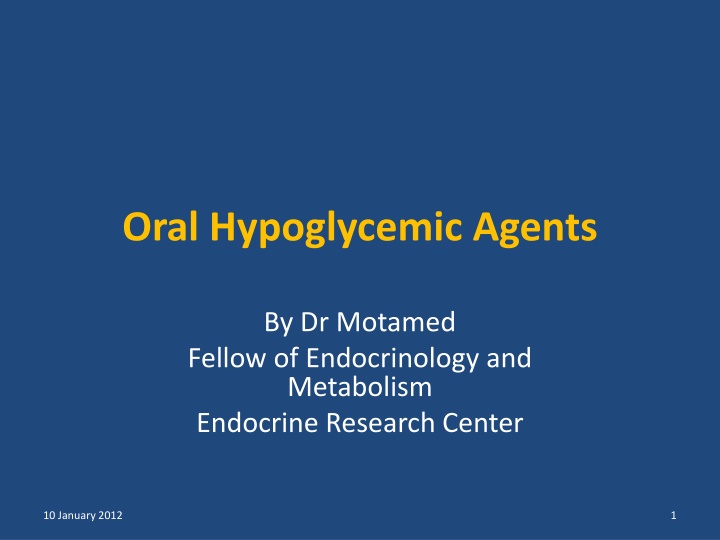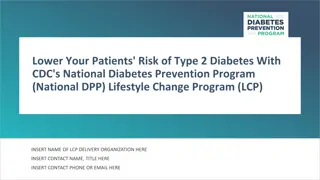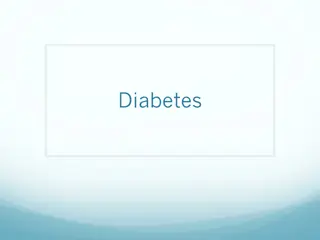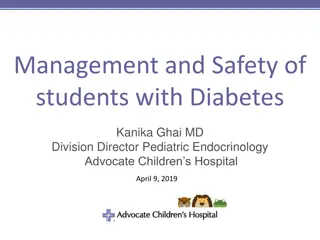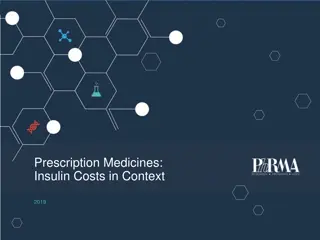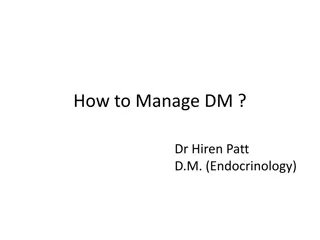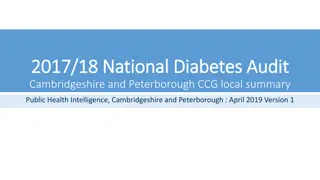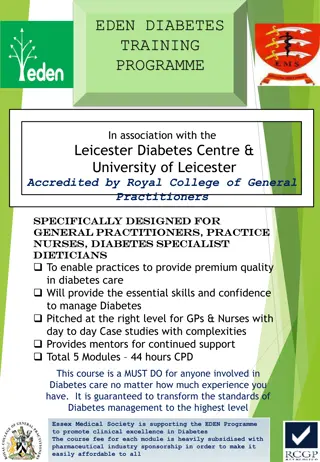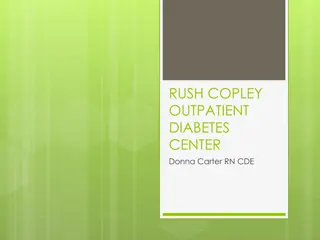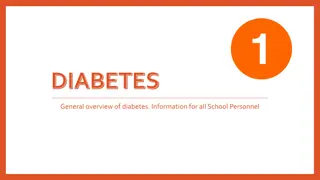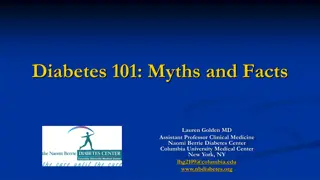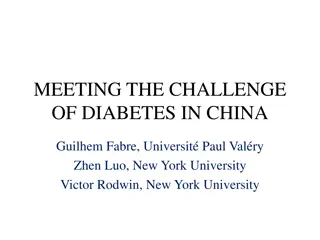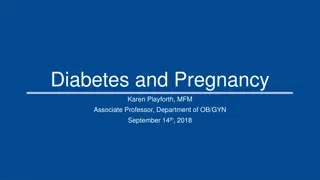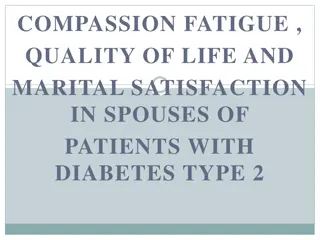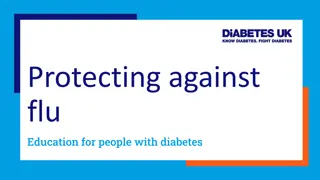Overview of Diabetes Management Options
This content provides valuable insights into oral hypoglycemic agents, the pathophysiology of type 2 diabetes, the importance of controlling blood glucose levels, and various therapeutic options available. It highlights key considerations in pharmacologic treatment, focusing on biguanides like metformin and their mechanisms of action. The relationship between HbA1C levels and microvascular complications is also discussed.
Download Presentation

Please find below an Image/Link to download the presentation.
The content on the website is provided AS IS for your information and personal use only. It may not be sold, licensed, or shared on other websites without obtaining consent from the author.If you encounter any issues during the download, it is possible that the publisher has removed the file from their server.
You are allowed to download the files provided on this website for personal or commercial use, subject to the condition that they are used lawfully. All files are the property of their respective owners.
The content on the website is provided AS IS for your information and personal use only. It may not be sold, licensed, or shared on other websites without obtaining consent from the author.
E N D
Presentation Transcript
Oral Hypoglycemic Agents By Dr Motamed Fellow of Endocrinology and Metabolism Endocrine Research Center 10 January 2012 1
Pathophysiology of Type 2 Diabetes Peripheral Tissues (Muscle) Receptor + post receptor defects Insulin resistance Glucose Liver Increased glucose production Pancreas Impaired insulin secretion 2
Relationship of HbA1C to Risk of Microvascular Complications Relative Risk (%) HbA1C (%) 3 Skyler JS. Endocrinol Metab Clin North Am. 1996;25:243-254.
Control of blood glucose is essential in diabetic patients with any possible method (Diet, Oral agents, or Insulin) Otherwise, The complications of diabetes will appear 4
There currently are four therapeutic options for type 2 diabetes: Increase insulin release with sulfonylureas or meglitinides Increase insulin responsiveness with a biguanide (metformin) or a thiazolidinedione Modify intestinal absorption of carbohydrate with an alpha-glucosidase inhibitor . Administer exogenous insulin 5
Pharmacologic Therapy for Type 2 Diabetes Sulfonylureas (glyburide or glibenclamide) Biguanides (metformin) Alpha-glucosidase inhibitors (acarbose) Benzoic acid analogues (repaglinide) Thiazolidinediones ( pioglitazone) Insulin (human insulin, insulin analogues) 6
Considerations in Pharmacologic Treatment of Type 2 Diabetes Efficacy (HbA1c lowering capacity) Mechanisms of action of drugs Impact on weight gain Complications/tolerability Frequency of hypoglycemia Compliance/complexity of regimen Cost 7
Metformin Skeletal glucose uptake inhibit hepatic gluconeogenesis Renal dysfunction may increase risk of lactic acidosis lactic acidosis an extremely rare (<1 case per 100,000 treated pts) but potentially fatal Should not be used in renal failure male Cr 1.5 mg/dL female Cr 1.4 mg/dL 9 Diabetes Care 2009; 32:193 203
Metformin is the only currently available biguanide. It is effective only in the presence of insulin its major effects are to decrease hepatic glucose output and increase insulin action 10
Property Metformin Target tissue Liver HbA1c (monotherapy) Fasting effect 1%-2% Good Postprandial effect Good Severe hypoglycemia No Dosing interval bid or tid Weight (lb/yr) 0 to - 6 Insulin Modest decrease LDL Decrease HDL Increase TG Decrease Common problem Transient GI Rare problem Lactic acidosis Contraindications Renal failure , Liver failure, CHF , >80 yr old Maximum effective dose 1000 mg bid Kronenberg: Williams Textbook of Endocrinology, 11th ed. 2008 Saunders 11
Metformin is available as 500 and 1000 mg tablets, and should be taken with meals. We begin with 500 mg once daily with the evening meal and, if tolerated, add a second 500 mg dose with breakfast. The dose can be increased slowly (one tablet every one to two weeks) as necessary to a maximum of 2500 mg/day 12
contraindications to the metformin therapy Renal insufficiency (serum creatinine concentration above 1.4 mg/dL in women and 1.5 mg/dL in men), low creatinine clearance Concurrent liver disease alcohol abuse Heart failure Past history of lactic acidosis 13
Severe infection with decreased tissue perfusion Hypoxic states Serious acute illness Hemodynamic instability intravenous iodinated contrast material 14
Sulfonylureas are the oldest class of oral hypoglycemic agents and are often used as a first line therapy(today is another recommendation) Their effectiveness decreases over time; after five years of treatment, addition of a second agent or insulin therapy is often necessary. 17
Sulfonylureas usually lower blood glucose concentrations by about 20 percent like metformin Different sulfonylureas are equally effective in lowering blood glucose concentrations. There are, however, differences in absorption and metabolism, as well as in effective dosage 18
Property Sulfonylureas Target tissue Beta cell HbA1c (monotherapy) Fasting effect 1%-2% Good Postprandial effect Good Severe hypoglycemia Yes Dosing interval Daily to tid Weight (lb/yr) +1 to 3 Insulin Increase LDL None HDL None TG None Common problem Hypoglycemia, weight gain Contraindications Allergy/GFR<50 Maximum effective dose max Kronenberg: Williams Textbook of Endocrinology, 11th ed. 2008 Saunders 19
Meglitinides 20
The meglitinides, repaglinide and nateglinide, are short-acting glucose- lowering drugs for therapy of patients with type 2 diabetes. These drugs have essentially no renal clearance and are safe in patients with renal failure . 21
MEGLITINIDES Repaglinide The recommended starting dose is 0.5 mg before each meal for patients who have not previously taken oral hypoglycemic drugs. The maximum dose is 4 mg before each meal; the dose should be skipped if the meal is missed 22
Property Glinides Target tissue Beta cell HbA1c (monotherapy) 1%-2% Fasting effect Mod Postprandial effect Good Severe hypoglycemia Yes Dosing interval tid to qid with meals Weight (lb/yr) +1 to 3 Insulin Increase LDL None HDL None TG None Common problem Hypoglycemia Maximum effective dose Re: 4 mg with each meal 23 Kronenberg: Williams Textbook of Endocrinology, 11th ed. 2008 Saunders
THIAZOLIDINEDIONES The thiazolidinediones increase insulin sensitivity by acting on muscle and liver (PPAR gama) They also improve insulin secretory dynamics in patients with impaired glucose tolerance and will delay or prevent DM development. 25
Example: Rosiglitazone [Avanidia] (2 to 4 mg twice daily) Pioglitazone [actos] (15 to 45 mg once daily) 26
Glitazones FDA recommends measurement of LFT prior to initiating therapy and at regular intervals (every 2 months for the first year and then periodically) Contraindicated in patients with active hepatocellular disease in patients with unexplained serum ALT >2.5 times the upper limit of normal 27
Property Glitazones Target tissue Muscle HbA1c (monotherapy) 0.5%-2% Fasting effect Good Postprandial effect Good Severe hypoglycemia No Dosing interval Pioglitazon: qd Weight (lb/yr) +1 to 13 Insulin Decrease LDL Increase HDL Increase TG Pioglitazon: Decrease Common problem Weight gain, edema, anemia Rare problem Hepatotoxicity Contraindications Hepatocellular disease, CHF (class III-IV) Maximum effective dose Pioglitazon: 45 mg qd 28 Kronenberg: Williams Textbook of Endocrinology, 11th ed. 2008 Saunders
Alpha-glucosidase inhibitors Acarbose is available as 50 and 100 mg tablets which should be taken with the first bite of each meal. We begin with 25 mg three times daily. Flatulence, diarrhea, and abdominal discomfort are dose related and almost always resolve if the dose is decreased. 30
Property -Glucosidase Inhibitors Target tissue Gut HbA1c (monotherapy) 0.5%-1% Fasting effect Poor Postprandial effect Excellent Severe hypoglycemia No Dosing interval bid to qid Weight (lb/yr) 0 to - 10 Insulin Modest decrease LDL Minimal decrease HDL None TG Minimal decrease Common problem Flatulence Contraindications Intestinal disease Maximum effective dose 50 mg tid 31 Kronenberg: Williams Textbook of Endocrinology, 11th ed. 2008 Saunders
Comparisons of Oral Anti-diabetic Drugs -Glucosidase Inhibitors Property Sulfonylureas Metformin Glitazones Glinides Target tissue Beta cell Liver Gut Muscle Beta cell HbA1c (monotherapy) 1%-2% 1%-2% 0.5%-1% 0.5%-2% Re: 1%-2% Fasting effect Good Good Poor Good Re: Mod Postprandial effect Good Good Excellent Good Re: Good Severe hypoglycemia Yes No No No Re: Yes Dosing interval qd to tid bid or tid bid to qid P: qd tid to qid with meals Weight (lb/yr) +1-3 0 to - 6 0 to - 10 +1-13 +1-3 Insulin Increase Modest decrease Modest decrease Decrease Increase LDL None Decrease Minimal decrease Increase None HDL None Increase None Increase None TG None Decrease Minimal decrease P: Decrease None Common problem Hypoglycemia, weight gain Transient GI Flatulence Weight gain, edema, anemia Hypoglycemia Rare problem Lactic acidosis Hepatotoxicity? Contraindications Allergy Renal failure Liver failure CHF >80 yr old Intestinal disease Hepatocellular disease Maximum effective dose max or double starting 1000 mg bid 50 mg tid P: 45 mg qd Re: 2 mg tid 32 Kronenberg: Williams Textbook of Endocrinology, 11th ed. 2008 Saunders
